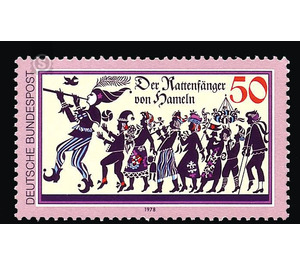Rat catcher from Hameln - Germany / Federal Republic of Germany 1978 - 50 Pfennig
Theme: Animals
| Country | Germany / Federal Republic of Germany |
| Issue Date | 1978 |
| Face Value | 50.00 |
| Color | orange violet |
| Perforation | K 14 |
| Printing Type | Six-color offset printing |
| Stamp Type | Postage stamp |
| Item Type | Stamp |
| Chronological Issue Number | 861 |
| Chronological Chapter | GER-BRD |
| SID | 268993 |
| In 51 Wishlists | |
If a German mythical figure can boast of world renown, then the Pied Piper of Hamelin. We do not know the day or place of the birth or the death of this man, we also do not know what historical truth behind the old and so emblematic history. What is certain is that in the year 1284 in Hameln something unusual must have happened, which is connected with the excerpt of 130 "city children". The earliest sources say nothing of a man who freed the city from a rat plague; Here only a piper appears whose flute tones the children of Hameln could not escape: "... and all the children who heard that pipe, almost 130 in number, followed him out to the Ostertor. They disappeared and left ... "(Manuscript of 1430). In a southern German chronicle of the 16th century, a "Pied Piper" appears for the first time. In return for his wages he freed Hameln from a plague of rats, was cheated out by the council for his wages, and avenged himself with the kidnapping of the "hämel children." This version is the basis of the Grimm's legend version and the verse poetry "The Pied Piper of Hamelyn" by Robert Browning. Over the centuries, attempts were repeatedly made to interpret the legend content. The latest research associates the exodus of children with settlement processes. According to this, in the last third of the thirteenth century, the bishop of Olomouc, a count of Schaumburg, had young people from Hamelin brought in by a »locator« to settle Moravia. Another thesis has Count von Spiegelberg, with 130 young Hamelners, set out for Pomerania, where they are "lost" on the subsequent trip to the Baltic. These interpretations are taken up by the modern Pied Piper fountain, created by Ulrich Nuss in 1975, whose statement is also followed by the special stamp designed by Günter Jacki. (Text: City of Hamelin)


